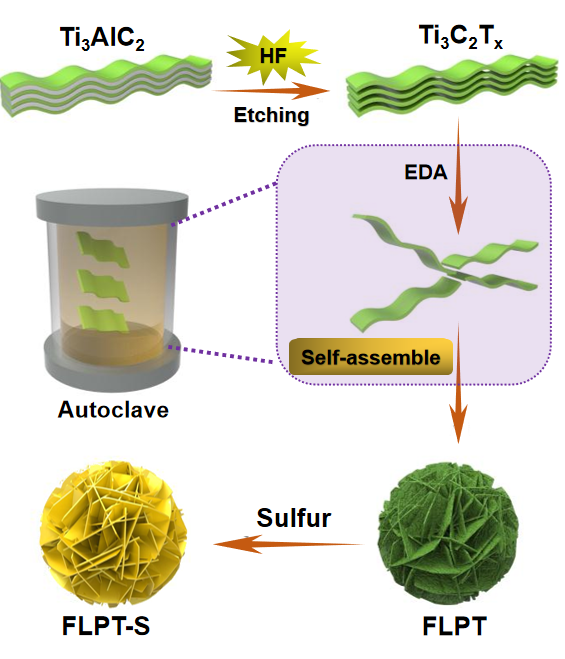Conductive carbons are promising sulfur host materials for improving areal capacity in lithium-sulfur (Li-S) batteries, but they face a few congenital deficiencies, such as low tap density and weak polysulfides entrapment ability. Thus, the carbon-based sulfur cathode usually exhibits poor volumetric performance.
In a study published in ACS Nano., the research group led by Prof. WANG Ruihu from Fujian Institute of Research on the Structure of Matter (FJIRSM) of the Chinese Academy of Sciences (CAS) reported one type of the cathode system based on flower-like porous Ti3C2Tx (FLPT) without the incorporation of any carbon hosts and conductive additives.
The active materials are tightly adhered on the surface of the Ti3C2Tx nanosheets, the space-efficient arrangement of primary Ti3C2Tx nanosheets results in high tap density in the FLPT-S composite, which substantially improves the volumetric sulfur content and thus volumetric capacity.
The abundant active sites in FLPT are preferable for strong chemisorption and catalytic conversion of polysulfides, which propels the redox reactions of sulfur species to occur on the surface of FLPT.
Researchers found that fast dynamic equilibrium between S62- and S3*- radical further promotes the solid-liquid-solid transformation of sulfur species in the charge/discharge processes.
The electrolyte penetration and ion transport between adjacent nanosheets are greatly accelerated by nanomesh structure in the Ti3C2Tx nanosheets.
Meanwhile, high conductivity of FLPT allows for rapid charge transfer in the nanosheets and even whole FLPT.
The resultant FLPT-S electrode synchronously acquires high areal capacity of 10.04 mAh cm-2 and ultrahigh volumetric capacity of 2009 mAh cm-3.
These performance metrics highlight the potential for MXene in miniaturized energy storage devices and foreshadow their applicability for a multitude of other devices.

Schematic illustration for the synthetic process of FLPT and FLPT-S composite. (Image by Prof. WANG’s Group)
Contact:
Prof. WANG Ruihu
Fujian Institute of Research on the Structure of Matter
Chinese Academy of Sciences
Email: ruihu@fjirsm.ac.cn